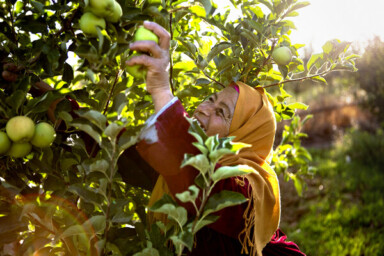The following is a chapter written by Patrick Holden from the book, The Harmony Debates: exploring a practical philosophy for a sustainable future. The book contains forty-three chapters examining the theory and practice of Harmony from a wide range of perspectives, from food and farming to education, the economy, sculpture, dance, theology and philosophy.
It includes contributors from the 2017 Sustainable Food Trust conference, ‘Harmony in Food and Farming’ at Llandovery College, which many of you attended, including Patrick Holden, Richard Dunne, Gunhild Stordalen, Tony Juniper, Helen Browning, John Eliot Gardiner and Dame Ellen MacArthur.
A Reflection on Harmony
The publication of Harmony: A New Way of Looking at Our World, has had a profound impact on my life. It has exerted a gentle, but increasingly potent influence in the world, germinating amongst many individuals, including myself, a seed of latent interest, which is, nine years later in my own case, beginning to find expression in my daily work.
Although I read the book shortly after it was published in 2010, it wasn’t until several years later that I began to understand its deeper significance. My first impression was that the Prince of Wales was just reminding us of things that I already knew – about various laws and principles, examples of which can be found in nature, music and in many other areas of life. My attitude was ‘yes, yes, I know all that, it is important. I am a lover of music, I have a spiritual search, I love to visit Gothic Cathedrals, but these are personal and private interests, and, in the meantime, I need to get on with my work in the more material world.’ I now see that what I did not fully realise is that the Prince’s calling is to remind us that there is, or should be, no separation between an esoteric understanding of these inner harmonic laws and principles, their expression in the physical universe and by extension, one’s work in the world.
By the time this seed of a potentially much deeper understanding of the Harmony philosophy and principles germinated in my mind, Richard Dunne, then headteacher at Ashley Church of England Primary School, had also read the book, but unlike me, he immediately understood its deeper significance. He was already a leader in primary school education, with a track record of OFSTED (Office for Standards in Education, Children’s Services and Skills) outstanding status and a strong interest in sustainability. Richard realised that despite his achievements, the educational practices in his school were failing to enable his pupils to make sense of the world in which they found themselves or to adequately prepare them to take on the environmental challenges threatening their future well-being. Inspired by the Prince’s book, he chose seven key principles that can help us live and work in harmony with Nature and with one another.
In effect, he was responding to the real message of the Harmony book. The Prince of Wales himself describes his message as revolutionary and a ‘call to action’, not merely action in thinking, but action in practice, and he is right! The phrase he uses – ‘a new way of looking at our world’ – needs to be interpreted quite literally. It is a revelation to understand the deeper significance of the Harmony message, and it requires action in the field of work in which one is already engaged. For Richard Dunne this meant embedding the Harmony principles in the educational timetable and curriculum at Ashley school. Since then, he has produced a guide which enables all teachers with an interest in the Harmony philosophy and principles to apply them on a daily and weekly basis in their particular school, in ways which would be compatible within the existing curriculum.
Inspired by his example, I began to ask myself the same question. If I too had experienced the same revelation, albeit a bit late in the day, how was I going to put this into practice in my field of work, namely food and farming? Because my day job is the Founder and Chief Executive of the Sustainable Food Trust, I thought one of the best ways to explore this question was to organise a conference around the theme of ‘Harmony in Food and Farming’, engaging with other leaders in other fields of activity which potentially could be revolutionised, to use the Prince’s words, by ‘the application of Harmony principles’.
I think it would be fair to say that everyone who attended the ‘Harmony in Food and Farming’ conference in 2017 – and there were more than 400 of them – was profoundly influenced by the atmosphere that was co-created by the participants. It was wonderful to hear The Prince of Wales speak and to be in the company of people like Dame Ellen MacArthur, Sir John Eliot Gardiner, Rupert Sheldrake, Sir Anthony Seldon, the Bishop of California Marc Andrus, Chef Barny Haughton and Tony Juniper, to name but a few, each of whom in their own way was interested in exploring this question – how could I review the work in which I am already involved through the lens of the Harmony principles and philosophy?
In light of my ongoing observations, the question I would like to pose is this: if we were to review our particular fields of activity through a Harmony lens, how would this inspiration find expression in our future work? The fields of activity where this question is relevant might include Governments, policy makers, NGOs, as well as those working in sectors such as the built environment, music and the arts, sports and tourism. In each one of these fields, the Harmony perspective can provide an antidote to the tendency towards siloed and reductionist thinking.
In relation to my own field of work, the conference marked the beginning of a new chapter. I intend to continue reviewing the work that I am already doing, striving to make sense of it in light of my awareness of the interconnectedness of everything, specifically related to the way in which the principles of Harmony manifest in my farming and in transforming our food and farming systems. It is my hope that this perspective will strengthen the capacity of the Sustainable Food Trust to have a transformative influence on our future food systems.
The progress that I have made to date is only the beginning – it is halting, it is tentative. However, what I have already realised is that it does not require a fundamental change of direction but rather a mindfulness that many of the activities I have already been practising have been informed intuitively by a subliminal understanding of these principles. Having been informed, inspired and empowered by a more conscious understanding of their existence, I can improve and enhance what I am already doing in my work as an individual, in the community and in the wider world.
As mentioned above, might I be bold enough to suggest that Prince Charles is actually calling each of us to undertake a parallel review of our work, against the backdrop of these extraordinary truths, known by the ancients, but perhaps forgotten? This, at least in part, relates to the grammar of Harmony, as expressed most perfectly in geometry but also in the movement of planets, in music, in maths, in nature, in the form of buildings…I could go on. This is, dare I say it, not only my enquiry, but it could form the heart of our future enquiries, if we are to make sense of the world in which we find ourselves and make it a more habitable and, perhaps, a better place for future generations.







